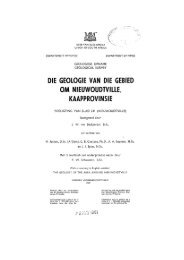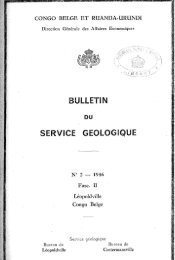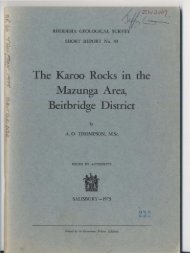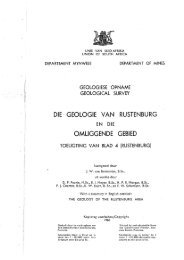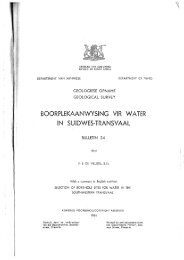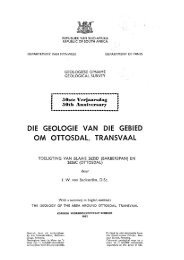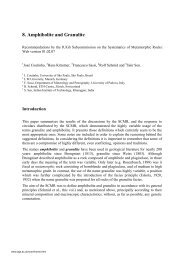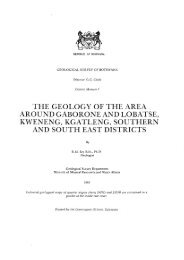Bibliography - British Geological Survey
Bibliography - British Geological Survey
Bibliography - British Geological Survey
Create successful ePaper yourself
Turn your PDF publications into a flip-book with our unique Google optimized e-Paper software.
stone derived from the Wealden deposits. ‘In addition to these, there occur occasionally brown-coated subangular<br />
flints, which agree so closely with those found in the Eoanthropus plateau (about 100 feet above)<br />
that it seems safe to assume their derivation from that source. To our great surprise we found associated with<br />
these expected constituents a not inconsiderable number of pebbles of quartzite and vein-quartz.’)<br />
Haywood, I. 1987. Faking it: art and politics in forgery. Brighton: Harvester Press. (Piltdown, pp. 90-103)<br />
Head, J. O. 1971. Piltdown mystery. New Scientist, 49 (14 Jan), 86. (Letter prompted by a commentary in<br />
New Scientist, 48 (10 Dec), 471, which reported Louis Leakey’s strong hint, as reported by the Sunday Times,<br />
that he believed the ‘hoaxer’ at Piltdown to have been Teilhard de Chardin. Mr Head recounts a conversation<br />
he had with Robert Essex, who knew both Dawson and Teilhard. ‘One of Essex’s points lay in his estimation<br />
of the personalities of the two men: Dawson being pompous, self-opinionated and unimaginative, far more<br />
likely to be the victim than perpetrator of such a hoax, whereas Teilhard was, as Leakey states, well known<br />
as a practical joker.’)<br />
Heal, V. 1980. Further light on Charles Dawson. Antiquity, 54 (Nov), no. 212, 222‒225. (Presents evidence<br />
that casts doubt on the authenticity of several of Dawson’s archaeological ‘discoveries’, notably a Neolithic<br />
flint hatchet in a wooden haft from East Dean and an ancient boat of clinker construction from Bexhill, neither<br />
of which was preserved. The author is a research student at Cambridge working on prehistoric wood technology<br />
in N.W. Europe. See also remarks by John H. Combridge 1981.)<br />
Heizer, R. F. & Cooke, S. F. 1954. Comments on the Piltdown remains. American Anthropologist, 56 (Feb),<br />
92–94. (In the light of their experience in investigating and evaluating fluorine and other constituents of<br />
archaeological human and animal bone, the authors draw certain conclusions from the findings of Weiner,<br />
Oakley and Le Gros Clark, as reported in Washburn 1953. They would regard the jaw, molar and canine of<br />
Piltdown I and the molar of Piltdown II as of very recent origin. The fluorine content of the bones mentioned<br />
does not exceed the range found in fresh bone, while the values for nitrogen content (3.9‒5.1%) all lie at or<br />
above the average value for fresh human and animal bone, which is about 4%. Even a relatively short period<br />
of interment of the order of 100 to 300 years, as shown by burials in culturally late California sites, reduces<br />
the nitrogen content rapidly to not higher than 3%. The Piltdown I skull, together with the frontal fragment<br />
of Piltdown II, all give indication of moderate age. On the other hand, the fluorine and nitrogen values for<br />
the occipital fragment of Piltdown II are conflicting and imply one of three possibilities: (1) a modern bone<br />
introduced as a hoax; (2) an archaeological specimen removed from its original site elsewhere and introduced<br />
to the Piltdown locality, or (3) an indigenous bone in the Piltdown gravels.)<br />
Henneberg, M., Eckhardt, R. B. & Schofield, J. 2011. The Hobbit trap: how new species are invented.<br />
2nd ed. Walnut Creek, California: Left Coast Press, xii, 215 pp. (First published in 2008 as The Hobbit<br />
trap: money, fame, science and the discovery of a ‘new species’. The book challenges the claims of Prof.<br />
Mike Morwood, an Australian archaeologist, to have discovered a new species of dwarfish human, Homo<br />
floresiensis, on the island of Flores in Indonesia. Excavated in 2004, and cannily nicknamed the ‘Hobbit’,<br />
this wholly unexpected species was stated to be only about 18,000 years old. While some scholars were<br />
quick to accept the validity of Homo floresiensis, the present writers have good reason to believe that the<br />
‘fossil’ is a comparatively modern Homo sapiens suffering from a well known genetic abnormality of the<br />
skull. The suggestion is also made that the Hobbit’s left lower first molar appears to have been drilled and<br />
subjected to modern dental work during its lifetime! Access to the remains in order to verify this point has<br />
for some time been denied. The authors end their book with the plea: ‘We hope this debate will not end the<br />
way the argument over Piltdown Man did. The truth – and the molar – are still out there.’)<br />
Hewitt, J. T. 1898. Note on natural gas at Heathfield Station (Sussex). Quarterly Journal of the <strong>Geological</strong><br />
Society of London, 54 (3) Aug, 572‒574 (with discuss). (See herein Dawson 1898b for comments)<br />
Hewitt, J. T. (for obituary see Turner 1955; Costello 1986 has implicated Hewitt in the Piltdown forgery;<br />
see also Daniel 1986)<br />
Hilber, V. 1915. Irrige Beziehungen zwischen Eoanthropus, Pithecanthropus, Heidelberger und<br />
Neandertaler Mensch. Zeitschrift für Morphologie und Anthropologie, 17, 503–504.<br />
Hill-Tout, C. 1921. The phylogeny of Man from a new angle. Transactions of the Royal Society of Canada,<br />
ser. 3, 15, sect. II, 47–82. (Piltdown, pp. 74–78)<br />
Hillaby, J. 1973. Who was the Piltdown Mephisto? New Scientist, 57 (15 Mar), 619‒620. (The writer has<br />
spent much time talking to people associated in one way or another with the Piltdown affair. He is highly



